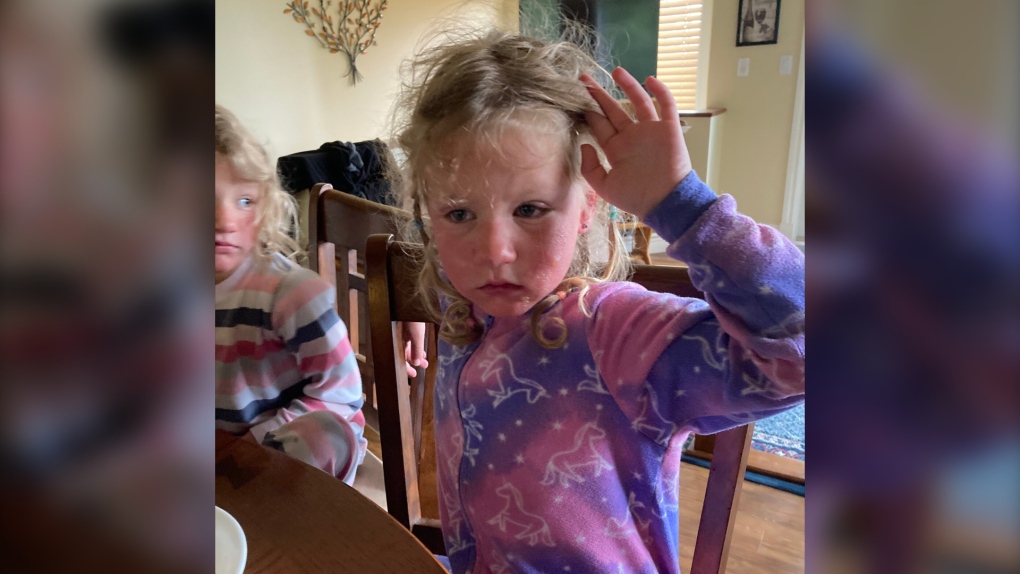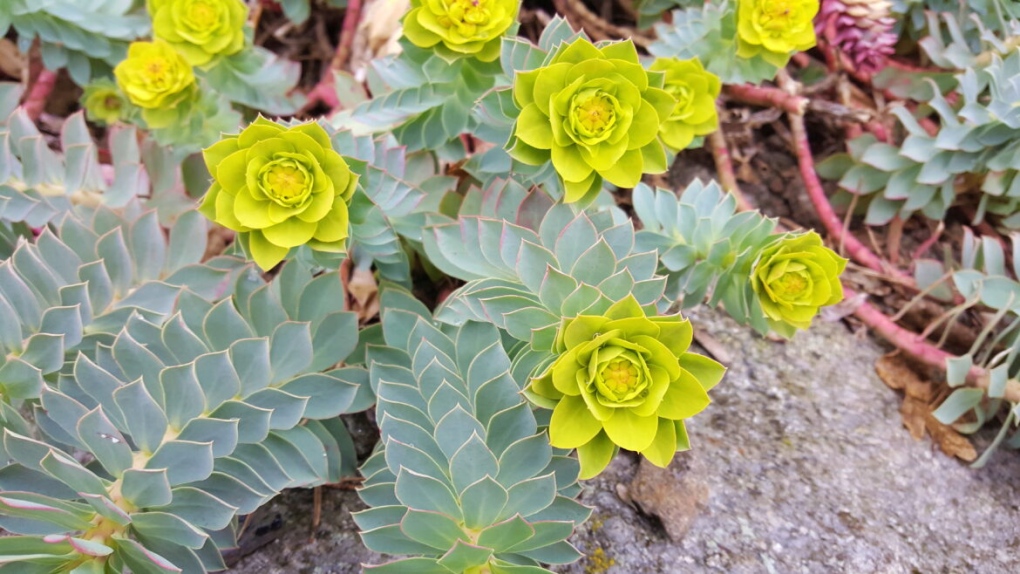Myrtle spurge: B.C. children left burned by invasive plant
 Two children suffering from the effects of Myrtle spurge contact are seen in an image from the Invasive Species Council of B.C.
Two children suffering from the effects of Myrtle spurge contact are seen in an image from the Invasive Species Council of B.C.
The Invasive Species Council of B.C. is asking the public to report sightings of a "highly toxic" plant that can leave people's skin blistered and burned – something one family recently learned the hard way.
Okanagan residents Doug and Sandra Nimmo were hosting their granddaughters over the July long weekend when the children came into contact with Myrtle spurge, a garden perennial that carries a nasty sap capable of causing blindness in severe cases.
Fortunately, the children, who had been picking plants for a bouquet, only woke up the next morning with red and irritated skin, according to the Invasive Species Council, which shared the family's story.
"They got out of bed, and I was shocked to see their faces puffed up with blisters," Sandra Nimmo told the ISCBC, adding that the children weren’t seriously hurt.
“They laughed when they saw their faces in the mirror, and it only took about a week and a half to clear their skin.”
Myrtle spurge, or euphorbia myrsinites, is described as an extremely aggressive invasive species from the Mediterranean that can quickly take over gardens and other green spaces.
If ingested, the plant can cause nausea, vomiting and diarrhea. To cause blindness, the sap has to come into contact with someone's eyes.
The Invasive Species Council said Myrtle spurge is recognizable by its small, yellow flowers and light blue-green leaves, which are sharp and spiral closely around the stem. The plant grows 10 to 15 cm tall and forms a "low, spreading mound," according to the ISCBC.
 Myrtle spurge is seen in an image from the Invasive Species Council of B.C.
Myrtle spurge is seen in an image from the Invasive Species Council of B.C.
The plants are mostly found in the Okanagan, where they thrive in its warm climate and dry soil. They’re also sometimes found for sale at garden centres, despite being provincially regulated.
"With our PlantWise program, we are working with growers, retailers, and consumers to spread the word about which invasive species shouldn’t be sold and grown in B.C.," ISCBC's Allison McCabe said in a statement. "Great alternatives to Myrtle spurge include Lanceleaf Stonecrop (sedum lanceolatum), a beautiful native succulent that thrives in hot, dry conditions.”
The Invasive Species Council of B.C. said people can find more alternatives through its Grow Me Instead website. Anyone who has been in contact with Myrtle spurge or another invasive species is urged to report it online.
CTVNews.ca Top Stories

BREAKING Bob Cole, veteran CBC broadcaster and former voice of 'Hockey Night in Canada,' dead at 90
Bob Cole, legendary CBC broadcaster and former voice of Hockey Night in Canada, has died. He was 90.
Harvey Weinstein's 2020 rape conviction overturned by N.Y. appeals court
New York's highest court on Thursday overturned Harvey Weinstein's 2020 rape conviction, reversing a landmark ruling of the #MeToo era in determining the trial judge improperly allowed women to testify about allegations against the ex-movie mogul that weren't part of the case.
BREAKING Honda to get up to $5B in govt help for EV battery, assembly plants
Honda is set to build an electric vehicle battery plant next to its Alliston, Ont., assembly plant, which it is retooling to produce fully electric vehicles, all part of a $15-billion project that is expected to include up to $5 billion in public money.
MPP Sarah Jama asked to leave Ontario legislature for wearing keffiyeh
MPP Sarah Jama was asked to leave the Legislative Assembly of Ontario by House Speaker Ted Arnott on Thursday for wearing a keffiyeh, a garment that is banned at Queen’s Park.
CTE: Researchers believe widespread brain injury may contribute to veteran suicide rate
Researchers are working to better understand if some Canadian military veterans may be suffering from Chronic Traumatic Encephalopathy, also known as CTE -- a disorder previously found in the brains of professional football and hockey players after their death.
1 arrested in northern Alberta during public shelter order
Residents of John D'Or Prairie, a community on the Little Red River Cree Nation in northern Alberta, were told to take shelter Thursday morning during a police operation.
Secret $70M Lotto Max winners break their silence
During a special winner celebration near their hometown, Doug and Enid shared the story of how they discovered they were holding a Lotto Max ticket worth $70 million and how they kept this huge secret for so long.
Remains from a mother-daughter cold case were found nearly 24 years later, after a deathbed confession from the suspect
A West Virginia father is getting some sense of closure after authorities found the remains of his young daughter and her mother following a deathbed confession from the man believed to have fatally shot them nearly two decades ago.
New deep-water channel allows first ship to pass Key bridge wreckage in Baltimore
The first cargo ship passed through a newly opened deep-water channel in Baltimore on Thursday after being stuck in the harbor since the Francis Scott Key Bridge collapsed four weeks ago, halting most maritime traffic through the city's port.































